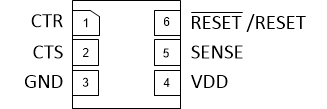SFFS287 September 2021 TPS3899
4 Pin Failure Mode Analysis (Pin FMA)
This section provides a Failure Mode Analysis (FMA) for the pins of the TPS3899. The failure modes covered in this document include the typical pin-by-pin failure scenarios:
- Pin short-circuited to Ground (see Table 4-2)
- Pin open-circuited (see Table 4-3)
- Pin short-circuited to an adjacent pin (see Table 4-4)
- Pin short-circuited to supply (see Table 4-5)
Table 4-2 through Table 4-5 also indicate how these pin conditions can affect the device as per the failure effects classification in Table 4-1.
| CLASS | FAILURE EFFECTS |
|---|---|
| A | Potential device damage that affects functionality |
| B | No device damage, but loss of functionality |
| C | No device damage, but performance degradation |
| D | No device damage, no impact to functionality or performance |
Figure 4-1 shows the TPS3899 pin diagram. For a detailed description of the device pins please refer to the Pin Configuration and Functions section in the TPS3899 data sheet.
 Figure 4-1 Pin Diagram
Figure 4-1 Pin DiagramFollowing are the assumptions of use and the device configuration assumed for the pin FMA in this section:
- Unless otherwise specified, it is assumed that the voltages applied to all the pins are within the Recommended Operating Range specified in the data sheet
- Note that voltage maximum for some pins is referenced to VDD
| PIN NAME | PIN NO. | DESCRIPTION OF POTENTIAL FAILURE EFFECT(S) | FAILURE EFFECT CLASS |
|---|---|---|---|
| CTR | 1 | No damage to device, can affect functionality. Forces RESET, RESET to be asserted. | B |
| CTS | 2 | No damage to device, can affect functionality. Forces RESET, RESET to be de-asserted. | B |
| GND | 3 | Normal operation. | D |
| VDD | 4 | No damage to device, can affect functionality. Shorts voltage supply to ground, increases system current. | C |
| SENSE | 5 | Defined operation, no damage to device. Forces RESET to be asserted. | C |
| RESET (open-drain) | 6 | No damage to device, can affect functionality. RESET stays asserted. Increased leakage current | B |
| RESET (push-pull) | 6 | May damage the device, can affect functionality. RESET stays asserted. Increased leakage current | A |
| PIN NAME | PIN NO. | DESCRIPTION OF POTENTIAL FAILURE EFFECT(S) | FAILURE EFFECT CLASS |
|---|---|---|---|
| CTR | 1 | Normal operation. | D |
| CTS | 2 | Normal operation. | D |
| GND | 3 | No damage to device, can affect functionality. Device is unpowered. | C |
| VDD | 4 | No damage to device, affects functionality. Device is unpowered. | B |
| SENSE | 5 | No damage to the device, sensed voltage indeterminate, output would be not as expected. | B |
| RESET (open-drain) | 6 | Reset functionality will be lost | B |
| RESET (push-pull) | 6 | Reset functionality will be lost | B |
| PIN NAME | PIN NO. | SHORTED TO | DESCRIPTION OF POTENTIAL FAILURE EFFECT(S) | FAILURE EFFECT CLASS |
|---|---|---|---|---|
| CTR | 1 | CTS | No damage to device, CTR, CTS delays not as expected. | C |
| CTS | 2 | GND | No damage to device, can affect functionality. Forces RESET, RESET to be de-asserted. | B |
| GND | 3 | VDD | No damage to device, can affect functionality. Shorts voltage supply to ground, increases current. | C |
| VDD | 4 | SENSE | No damage to device, can affect functionality. RESET, RESET does not pull low | B |
| SENSE | 5 | RESET (open-drain) | Potential damage to device and loss of functionality due to RESET pulling low fighting against SENSE. | A |
| SENSE | 5 | RESET (push-pull) | Potential damage to device and loss of functionality due to RESET pulling low and high fighting against SENSE. | A |
| RESET (open-drain) | 6 | CTR | No damage to device, can affect functionality. RESET does not pull high | C |
| RESET (push-pull) | 6 | CTR | No damage to device, can affect functionality. RESET does not pull high | C |
| PIN NAME | PIN NO. | DESCRIPTION OF POTENTIAL FAILURE EFFECT(S) | FAILURE EFFECT CLASS |
|---|---|---|---|
| CTR | 1 | No damage to device, can affection functionality. Forces RESET, RESET to be de-asserted. | B |
| CTS | 2 | No damage to device, can affection functionality. Forces RESET, RESET to be asserted. | B |
| GND | 3 | No damage to device, can affect functionality. Shorts voltage supply to ground, increases system current. | C |
| VDD | 4 | Normal operation. | D |
| SENSE | 5 | No damage to device, can affect functionality. RESET, RESET does not pull low | B |
| RESET (open-drain) | 6 | Might damage to device, can affect functionality. RESET stuck high. Increased leakage current. | A |
| RESET (push-pull) | 6 | Might damage the device, affects functionality. Increased leakage current | A |